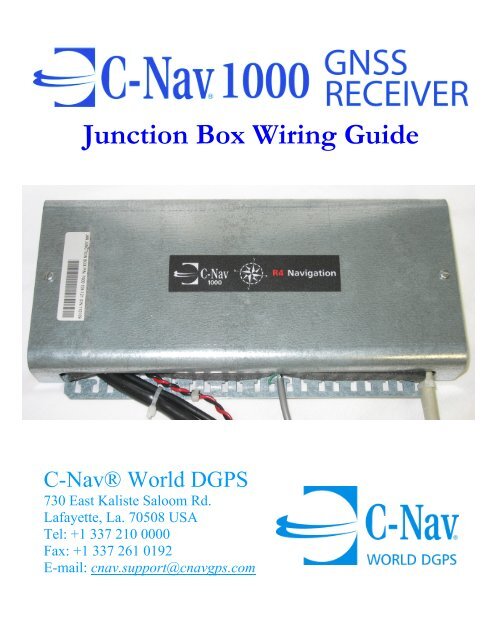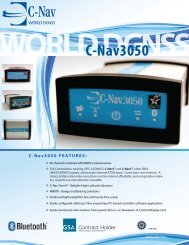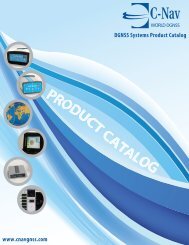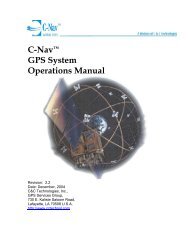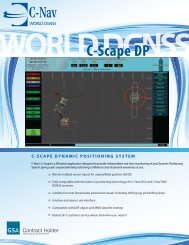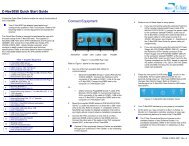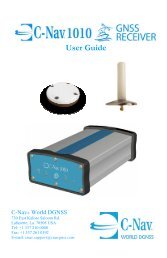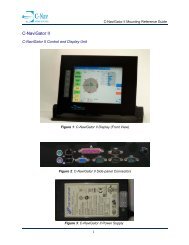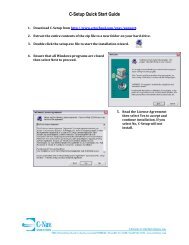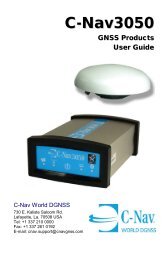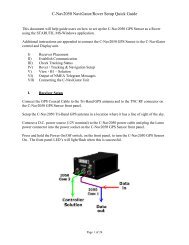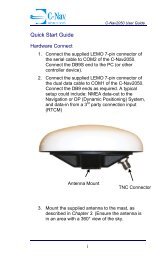Junction Box Wiring Guide - C-Nav World DGNSS
Junction Box Wiring Guide - C-Nav World DGNSS
Junction Box Wiring Guide - C-Nav World DGNSS
- No tags were found...
You also want an ePaper? Increase the reach of your titles
YUMPU automatically turns print PDFs into web optimized ePapers that Google loves.
<strong>Junction</strong> <strong>Box</strong> <strong>Wiring</strong> <strong>Guide</strong>C-<strong>Nav</strong>® <strong>World</strong> DGPS730 East Kaliste Saloom Rd.Lafayette, La. 70508 USATel: +1 337 210 0000Fax: +1 337 261 0192E-mail: cnav.support@cnavgps.com
®Contact the C-<strong>Nav</strong> office or dealernearest you:C-<strong>Nav</strong> Regional Office and Regional Distributor Contacts:North America:South America:Africa:Asia:Europe:Lafayette (Head Office): +1 337 210 0000Houston: +1 713 468 1536Rio de Janeiro: +55 21 2172 4000South Africa: +27 21 705 2741Angola: +244 222 330202Singapore: +65 6295 9738China: +86 139 1178 0036India: +91 22 27619975Indonesia: +62 21 521 3835Japan: +81 35 312 4600U.A.E.: +971 50 642 4419Vietnam: +844 754 3216UK – Bury St. Edmunds: +44 1284 703800Norway: +47 5779 6070Russia: +7 095 763 0665
CopyrightPage iiCopyrightThe entire contents of this manual and its appendices, includingany future updates and modifications, shall remain the property ofC & C Technologies, Inc. at all times. The contents must not,whether in its original form or modified, be wholly or partly copiedor reproduced, nor used for any other purpose than the subject ofthis manual.iiDisclaimerWhile reasonable care has been exercised in the preparation of thisinstallation guide, C & C Technologies, Inc. shall incur noliability whatsoever based on the contents or lack of contents in theinstallation guide.iiiValidity of this DocumentThis installation guide is valid for the J4N <strong>Junction</strong> <strong>Box</strong>, partnumber 7000 109-121ivInstallation <strong>Guide</strong> Part Number and RevisionPart number 7000 109-126, revision A1
CONTENTSPage iiCONTENTS1 INTRODUCTION 11.1 About this installation guide 11.2 Unpacking the equipment 12 GENERAL INFORMATION 12.1 Physical Size (mm) 12.2 Cabling 22.3 Power Supply 22.4 Clearance area (mm) 32.5 J4N Alarm Relay 32.6 J4N Circuit Board 33 MOUNTING THE BOX 54 CONNECTING R4 NAVIGATION SENSOR AND DISPLAY CABLES 54.1 Installing the R4 <strong>Nav</strong>igation Sensor Power and Data Cable 54.2 Installing the R4 Display Power Cable 64.3 Installing the R4 Display Signal Cable 65 REDUNDANT & COMBINED AIS/NAV INSTALLATIONS 75.1 Redundant System Installation 75.2 Combined AIS/<strong>Nav</strong> System Installation 86 TECHNICAL SPECIFICATIONS 10Appendix A: J4N Schematic 12Appendix B: J4N PCA Layout 13
INTRODUCTION Page 11 INTRODUCTION1.1 About this installation guideThis installation guide provides information to facilitate installationof the Saab TransponderTech J4N <strong>Junction</strong> <strong>Box</strong> for the R4 (D)GPS<strong>Nav</strong>igation System.As the J4N <strong>Junction</strong> <strong>Box</strong> is intended for use with the R4 <strong>Nav</strong>igationSystem, this installation guide contains information that is relevantfor this type of installation. It is important to note that more details ofthe R4 <strong>Nav</strong>igation System installation are found in the InstallationManual for the R4 <strong>Nav</strong>igation System (part number 7000 109-009).The main part of this installation guide concerns the basic standalonenavigation configuration. Additional information related todual redundant and combined AIS/navigation installations areprovided in chapter five.1.2 Unpacking the equipmentWhen unpacking the equipment, please check that the following isincluded in the delivered package, if any parts are missing, pleasecontact the Saab TransponderTech dealer.Standard J4N package:NameQty.J4N Unit 1Mounting Screws (In plastic bag located 4inside the box)2 GENERAL INFORMATION2.1 Physical Size (mm)
GENERAL INFORMATION Page 22.2 CablingThis guide details how to mount the standard cables that are includedin the standard delivery package for the R4 <strong>Nav</strong>igation System.• R4 <strong>Nav</strong>igation Sensor Power and Data Cable, part number7000 109-011.• R4 Display Power Cable, part number 7000 108-132.• R4 Display Signal Cable, part number 7000 108-133.The basic configuration is shown below.Figure 1: Overview of R4 <strong>Nav</strong>igation System installation2.3 Power SupplyThe R4 <strong>Nav</strong>igation System (sensor and display) is designed tooperate on 24 volts DC. The nominal power used by the display andsensor is 11.2 W.The J4N <strong>Junction</strong> <strong>Box</strong> includes the required fuses for the display andnavigation sensor (2 and 1 Amperes respectively).
GENERAL INFORMATION Page 32.4 Clearance area (mm)Leave a clearance around the J4N <strong>Junction</strong> <strong>Box</strong> to facilitate serviceand installation. See recommended clearance area below.Figure 2: Recommended clearance area2.5 J4N Alarm RelayThe J4N junction box includes a relay (RE1) driven by the discretealarm output of the R4 <strong>Nav</strong>igation Sensor. The relay switch may beconnected to an audible alarm device or the ship’s alarm system. Anexternal switch for acknowledge of alarms may also be connected.The R4 <strong>Nav</strong>igation System also facilitates alarm messages andacknowledge of alarms in serial ‘NMEA’ format. Refer to the R4<strong>Nav</strong>igation System installation manual for details.2.6 J4N Circuit BoardThe components and available connections of the J4N circuit boardare shown in figure 3 and listed in table 1 below. The schematic forthe J4N circuit board is included in Appendix A of this installationguide.
GENERAL INFORMATION Page 4Figure 3: J4N Circuit Board LayoutItemK1K2K3K4K5DescriptionTerminal block for R4 Display power cable.Terminal block for R4 <strong>Nav</strong>igation Sensor power and data cable.Terminal block for R4 Display signal cable.Terminal block for common external grounding of cable shields, if required.Terminal block for R4 Display front plug (Pilot Port).K6 Terminal block for User Port 3.K7K8Auxiliary terminal block for User Port 3 Tx lines.Terminal block for User Port 2 (This port is Tx only).K9 Auxiliary terminal block for User Port 2.K10Auxiliary terminal block for R4 <strong>Nav</strong>igation Sensor System Port Tx lines.K11 Terminal block for User Port 1.K12K13K14K15K16JP1RE1F1F2Auxiliary terminal block for User Port 1 Tx lines.Terminal block for speed log pulse output.Terminal block for external alarm acknowledge switch.Terminal block for alarm relay. ‘NC’ (normally closed) /’NO’ (normally open) refers to thenormally powered state of the relay under no-alarm conditions.Terminal block for 24V DC power. Dual terminals are available for re-distribution of powerin multi-system configurations.Jumper point for connection of signal shields to the junction box chassis, if required. Perdefault unpopulated (open).Alarm relay.1 Ampere fuse for R4 <strong>Nav</strong>igation Sensor.2 Amperes fuse for R4 Display.Table 1: J4N Circuit Board Components
MOUNTING THE BOX Page 53 MOUNTING THE BOX1. Open the lid of the J4N <strong>Junction</strong> <strong>Box</strong>2. Fix the box on an appropriate surface with the 4 supplied screws.Use the four holes that are located in each corner of the bottomplate.3. Connect the R4 <strong>Nav</strong>igation Sensor power and data cable, the R4Display power cable and the R4 Display signal cable as describedin the next section below.4. Connect cables to external equipment as required in accordancewith table 1 and indications on the J4N board. Refer to theinstallation manual for the R4 <strong>Nav</strong>igation system for detailsrelating to the external interfaces if required.5. Clamp the cables to the clamp area located on the front of the box.6. Fix the lid to the box casing7. If needed, also clamp the cable outside the box.4 CONNECTING R4 NAVIGATION SENSOR AND DISPLAY CABLES4.1 Installing the R4 <strong>Nav</strong>igation Sensor Power and Data CableConnect the R4 <strong>Nav</strong>igation Sensor power and data cable to the J4N<strong>Junction</strong> <strong>Box</strong> terminal block K2 as indicated in figure 4 below.Note: The shield of the R4 <strong>Nav</strong>igation Sensor power and data cableis connected to power supply return. It is not connected to the othershields in J4N and may be left unconnected (and properly isolated ifso required).Figure 4: Connection between J4N and the R4 <strong>Nav</strong>igation Sensor
CONNECTING R4 NAVIGATION SENSOR Page 64.2 Installing the R4 Display Power CableConnect the power cable for the R4 Display to the J4N <strong>Junction</strong> <strong>Box</strong>terminal block K1 as indicated in figure 5 below.Note: The ‘shield’ of the R4 Display power cable is not used in thecable or display. It is not connected to the other shields in J4N andmay be left unconnected.Figure 5: Power connection between J4N and the R4 Display4.3 Installing the R4 Display Signal CableConnect the signal cable for the R4 Display to the J4N <strong>Junction</strong> <strong>Box</strong>terminal block K3 as indicated in figure 6 below.Figure 6: Signal connection between J4N and the R4 Display
REDUNDANT & COMBINED AIS/NAV Page 75 REDUNDANT & COMBINED AIS/NAV INSTALLATIONS5.1 Redundant System InstallationTwo R4 <strong>Nav</strong>igation Systems may be interconnected in a ‘redundantconfiguration’ thus enabling them to automatically share databaseand navigation settings.In order to accomplish this, the Tx lines of the User 3 port on onesystem shall be connected to the Rx lines of the other system andvice versa. Refer to figure 7 for a suggested configuration using twoJ4N <strong>Junction</strong> <strong>Box</strong>es.In order to enable synchronized operation, one unit must beconfigured as ‘master’ and the other unit as ‘slave’. For furtherdetails refer to the operators manual for the R4 <strong>Nav</strong>igation System.Figure 7: Dual redundant system installation
REDUNDANT & COMBINED AIS/NAV Page 85.2 Combined AIS/<strong>Nav</strong> System InstallationThe R4 Combined AIS and <strong>Nav</strong>igation system combines the R4<strong>Nav</strong>igation System with the R4 AIS Transponder system using asingle display. A suggested installation using the J4N <strong>Junction</strong> <strong>Box</strong>and a J4 <strong>Junction</strong> <strong>Box</strong> for the AIS transponder system (part number7000 100-165) is outlined in figure 8.Figure 8: R4 Combined AIS and <strong>Nav</strong>igation System installationOptionally, the R4 Display signal cable leads can be connecteddirectly to the terminal blocks of J4 & J4N <strong>Junction</strong> <strong>Box</strong>es asfollows.
REDUNDANT & COMBINED AIS/NAV Page 9Figure 9: Optional Combined AIS/<strong>Nav</strong> system installationFigure 8: Optional display connection in combined AIS and <strong>Nav</strong>igation System installationIn this case, the leads of the R4 Display signal cable shall beconnected according to the table below.<strong>Junction</strong> <strong>Box</strong> /Terminal BlockTerminal Display datacable leadJ4N / K3 R4 Display R4 Sensor port Rx A Gray 11J4N / K3 R4 Display R4 Sensor port Rx B Pink 10J4N / K3 R4 Display R4 Sensor port Tx A White 5J4N / K3 R4 Display R4 Sensor port Tx B Brown 2J4 / K3 - Pilot Rx A Red/Blue 15J4 / K3 - Pilot Rx B Gray/Pink 18J4 / K3 - Pilot Tx A Violet 13J4 / K3 - Pilot Tx B Black 16J4 / K6 - Display Rx A Green 3J4 / K6 - Display Rx B Yellow 1J4 / K6 - Display Tx A Blue 8J4 / K6 - Display Tx B Red 7Displayconnector pinTable 2: Connection of R4 Display signal cable in a combined AIS/<strong>Nav</strong> installation.
TECHNICAL SPECIFICATIONS Page 106 TECHNICAL SPECIFICATIONSPHYSICALDimensions: Height: 37 millimetersWidth: 262 millimetersDepth: 130 millimetersWeight:0.95 kilogramsJ4N ALARM RELAYMax switching current:Max switching voltage:Max switching power:3 A250 VDC or 230 VAC60W (DC) or 120 VA (AC) resistiveload
TECHNICAL SPECIFICATIONS Page 11
TECHNICAL SPECIFICATIONS Page 12APPENDIX A: J4N SCHEMATIC
TECHNICAL SPECIFICATIONS Page 13APPENDIX B: J4N PCA LAYOUT


